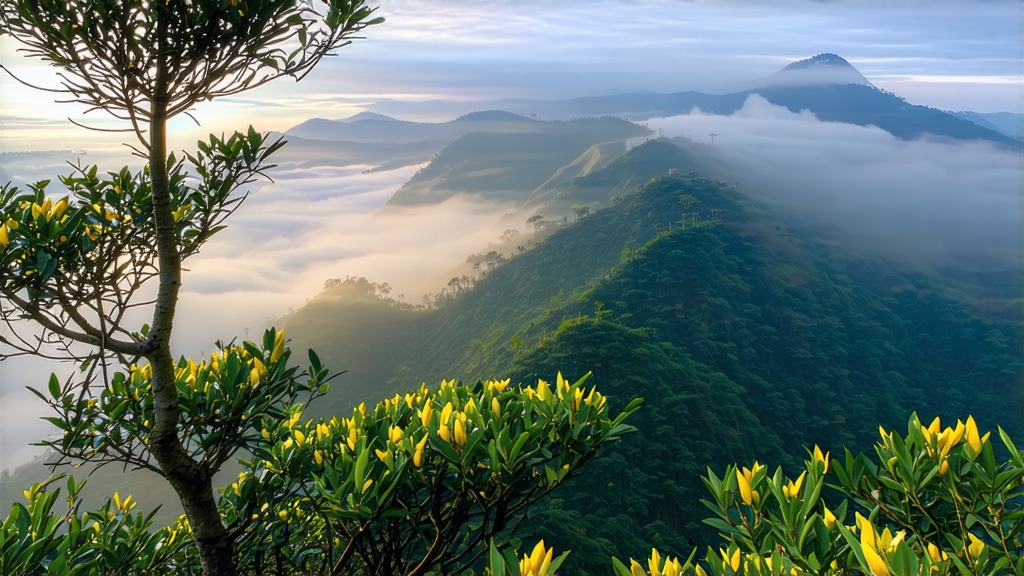
High on Mengding Mountain, where Sichuan’s mist rolls over ridges older than the Han dynasty, a tea fit for emperors is still picked by hand at daybreak. Mengding Huangya—literally “Yellow Bud from Mengding”—is the least-known yet most aristocratic member of China’s yellow-tea family. While dragon-well green or iron-oolong fill Instagram feeds, this luminous yellow-leaf tea lingers in quiet anonymity, guarded by altitude, tradition, and a curing process so subtle it feels like alchemy. To understand Mengding Huangya is to step into a pocket of Chinese history where color, scent, and taste were once currency in the imperial court, and where a single bud could carry the memory of an entire mountain.
History: from immortal to emperor
Legend places the first planting at 53 BCE, when the Taoist herbalist Wu Lizhen planted seven tea bushes on the summit, declaring them “immortal bushes.” By the Tang dynasty (618-907) the mountain’s tea was taxed; by the Song (960-1279) it was presented in little wax-sealed bamboo tubes to the palace. The Ming Hongwu Emperor (r. 1368-1398) formally listed “Mengding Yellow Bud” among the eight tribute teas, and Qing annals record 325 kilograms shipped annually to Beijing, packed in silk, escorted by cavalry. After the 1911 revolution the tribute system collapsed; farmers switched to faster-paying greens, and Huangya slipped into near extinction. A 1959 government survey found only 2.3 mu (0.15 ha) of old bushes left. Revival began in 1978 when agronomist Wang Xiaoyun collected 300 grams of ancestral seed, propagated them in mist-cooled nurseries, and spent eight years re-learning the lost “yellowing” technique. Today 1,200 mu on five peaks are certified origin-protected, yielding barely six tons a year—rarer than silver-needle white tea.
Micro-terroir: why the mountain makes yellow
Mengding rises to 1,456 m where the Sichuan basin meets the Tibetan Plateau. Night temperatures drop 12 °C within hours, forcing the tea plant to convert starches into soluble sugars and amino acids. Year-round cloud cover filters UV-B, boosting L-theanine and reducing catechins, giving the leaf an innate sweetness that survives the yellowing process. The soil is purple sandy loam derived from Jurassic sandstone, acidic (pH 4.9), rich in ion-exchangeable potassium—ideal for slow bud growth. Spring fog condenses on bamboo leaves and drips evenly, so the bushes receive moisture without direct rain that would bruise tender tips. Locals say “three days fog, one day sun” is the secret recipe for yellow buds.
Raw material: the golden standard
Only the single unopened bud plus half-moon first leaf (“one bud, one leaf, initial unfold”) is plucked. Pickers climb 400 m of stone steps before dawn so that leaf temperature stays below 15 °C, preventing premature enzymatic oxidation. The ideal bud is 18–22 mm long, silvery white on the underside, with 7 % moisture content at pluck. A skilled picker gathers 400 g in four hours; 4.2 kg of fresh buds yield 1 kg of finished tea.
Craft: the invisible 48 hours
Yellow tea’s defining step is “sealed yellowing” (men huang), a controlled micro-fermentation that turns chlorophyll into pheophytin without the microbial riot of black tea. Mengding Huangya uses the ancient “low-heat pile” method resurrected by Wang Xiaoyun.
- Sha-qing (kill-green): 160 °C bamboo-roast for 3 min 20 s, hand-tossed in a 1.2 m wok lined with fresh tea-oil cloth. The leaf loses 30 % weight, enzymes deactivated but surface microbes survive.
- Re-moistening: hot leaves are wrapped in steamed Meng bamboo mats for 8 minutes; internal temperature stays at 45 °C, rehydrating the leaf to 55 % moisture—critical for yellowing.
- First yellowing: piles of 2 kg are placed inside square oak boxes, covered with wet calico, then slid into a cave-like room kept at 28 °C and 78 % RH. For 24 hours the leaf “